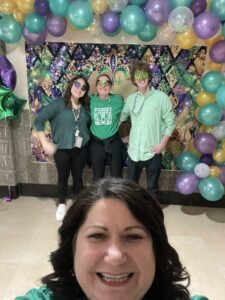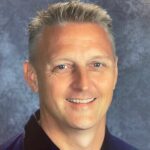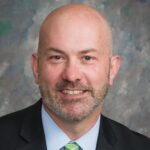The “Portrait of a Lion Learner” is a future-ready mindset that emphasizes critical thinking, lifelong learning, compassion and courageous inquiry, says one of District Administration’s superintendents to watch. These concepts form the basis of the South Fayette Township School District’s “portrait of a graduate” initiative to empower students to find their place in the world after high school, says Michelle Miller, superintendent of the Pittsburgh-area district.
“We believe that a future-ready learner is one who has had their individual passions, interests and strengths deeply enhanced so that whatever their future holds, they are equipped and prepared to make a successful transition after graduation,” Miller says.
South Fayette’s work is an example of how District Administration’s latest group of “Superintendents to Watch” is looking out for students as they move on to college and careers.
Keeping pace with the world
The Portrait of a Lion Learner skills have been embedded into South Fayette’s curriculum and teachers are continuously refining them in their classrooms. To support these efforts, Miller and her team are conducting classroom walkthroughs to get a better sense of how students are self-assessing their development of these skills. Next on the district’s to-do list is developing a “Portrait of a Lion Educator” to ensure teachers and administrators are honing their lifelong learning skills, Miller says.

Computational thinking skills are another major component of the future-ready focus. The district has been at the forefront of the push to expand STEAM instruction, open maker spaces at school, and make coding a regular part of the curriculum, Miller says, adding that the efforts are paying off.
More girls are engaging in science-related subjects, teachers are incorporating multidisciplinary units in STEAM instruction, and South Fayette’s graduates are now more likely to study computer science or engineering in college.
“We cannot live in the past or assume the present will be our students’ reality,” Miller says. “Instead, we must be visionaries. We must be thinking about the skills and attributes that a person needs to successfully navigate their future.”
The district’s 2022-2025 strategic plan, which was approved in May, sets several goals for the future.
- Support the well-being of the whole learner and school staff
- Increase the academic growth and achievement for all learners
- Address future growth and demographics in enrollment to anticipate needs and plan for expansion
- Create a comprehensive communications plan to engage and involve our community, families, and learners
- Expand and strengthen learning opportunities for learners to support the Future of Work
- Graduates possess at least one college credit and/or a professional/industry certification
- Align curriculum and instruction with an embedded focus on diversity, equity, inclusion and belonging
“A school district’s biggest challenge is keeping pace with the ever-changing world,” Miller says. “Each day, technology is changing and evolving. As a student enters kindergarten, we must remain diligent in creating experiences over a 13-year period for a world that will be vastly different from the one they experience as a 5-year-old.”
Rethinking the system’s vision for learning

The expectations for students in the least affluent districts should be as lofty as they are for students in the most high-achieving schools. One way to accomplish this is by building strong relationships with their students, says Mark Odsather, superintendent of Pleasant View Elementary School District in central California.
Each student in the district is assigned a mentor with whom they meet at least weekly during the school day to set personal growth and academic targets. “We focus on self-efficacy and shaping a belief system in which kids believe in their abilities,” Odsather says.
Another key is to redesign schools so teachers and other educators contribute to—and comprehend—the school system’s vision for learning. “Something is not right about the way the system works, if educators don’t feel connected to what they do,” Odsather says. In his district, teachers encouraged administrators to literally take down the walls between classrooms. The renovations gave teachers more opportunities to co-teach and collaborate around meeting the needs of each individual student.
The district’s goal is to have practitioners, not policymakers, take the lead in transforming K-12 as those educators become more nimble and flexible in their approach. “We’re now more connected to each other to hold each other responsible,” Odsather says. “When we see kids take off on the academic side, it’s because they have strong relationships with so many of our staff.”
Teachers bring in a lot of speakers, such as engineers and nonprofit leaders, who have gotten students involved in more engaging projects inside and outside the classroom. Students are building circuit boards and learning how to use software and other equipment to, for example, track endangered turtles in nearby mountains. And seventh-graders have been flying drones to monitor soil-moisture levels.
More from DA: Strategic plans are a big deal, right? Take a look at the latest from 3 districts
But the pandemic was a setback for students who were becoming more self-sufficient and learning self-regulation skills such as making enough time to study. The district has been working on reinstilling those characteristics and rebuilding classroom communities since reopening for in-person learning. As a result, the district hit a 10-year low for suspensions this past school year.
“What I’m most hopeful about is that something in our system is now functioning differently around learning,” Odsather says. “I’m seeing structures develop in classrooms that are coherent across K-8. Schools have the momentum to rethink a lot of things.”
Resourceful and resilient

Naperville Community Unit School District 203 is a high-achieving school system where students face high expectations and high pressure. That’s why educating the community—and winning family support—was crucial as the Chicago-area district’s educators worked to embed social-emotional cognitive growth into every aspect of instruction, Superintendent Dan Bridges says.
“It was important for the community to recognize the importance of balancing academic rigor with mental health,” says Bridges, whose district is now an SEL model in the Lighthouse Schools Systems Learning 2025 program developed by AASA, the Superintendents Association. “SEL is often viewed as something that it is not. We’re educating the community that it’s an integral part of an inclusive school community where students have a sense of belonging and feel they have a voice.”
High school students use that voice in twice-weekly advisory sessions designed to help them build stronger relationships with teachers and other staff members. SEL is integrated across the curriculum to help students develop self-awareness and self-management skills. Third-graders, for instance, work to identify emotions and social-acceptable behavior. In fifth grade, students might describe situations that cause a variety of behaviors.
In math, students will be asked to persevere when seeking solutions and describe different approaches to problem-solving as they make sense of their assignments. “SEL is not something that occurs within a schedule or at a certain time on a certain day,” Bridges says. “It’s fully integrated and embedded into all that we do.”
Superintendents Summit
The District Administration Superintendents Summit offers cutting-edge professional development to school district superintendents and other senior education executives to inspire innovation and leadership excellence in K-12 education. Upcoming events in this series:
Nov 9 – Nov 11: Omni La Costa Resort & Spa, Carlsbad, CA
Dec 14 – Dec 16: Ponte Vedra Inn & Club, Ponte Vedra, FL
The district also offers webinars so parents can continue the SEL work at home by supporting student mental health and practicing responsible digital citizenship. Bridges and the members of his leadership team have also tasked themselves with conducting wellness checks on the district’s educators.
Naperville’s SEL work began outside the classroom about eight years ago with a series of community meetings where stakeholders discussed where the district was succeeding and where it needed to improve. The feedback shaped the district’s whole child philosophy of giving equal attention to academic outcomes and students’ mental health in building an inclusive school community.
To clearly define its goals around SEL, the district spent about two years on professional development before fully introducing social-emotional learning to students. Teachers also work on SEL on an ongoing basis in their professional learning communities. In the coming years, Bridges and his educators will work to further personalize both academic and social-emotional learning for each student.
“We know students who engage in social-emotional learning and who get mental health support see better outcomes in school and in life,” Bridges says. “Our vision is for all students to utilize SEL and their academic skills to become resourceful, resilient, lifelong learners.”







